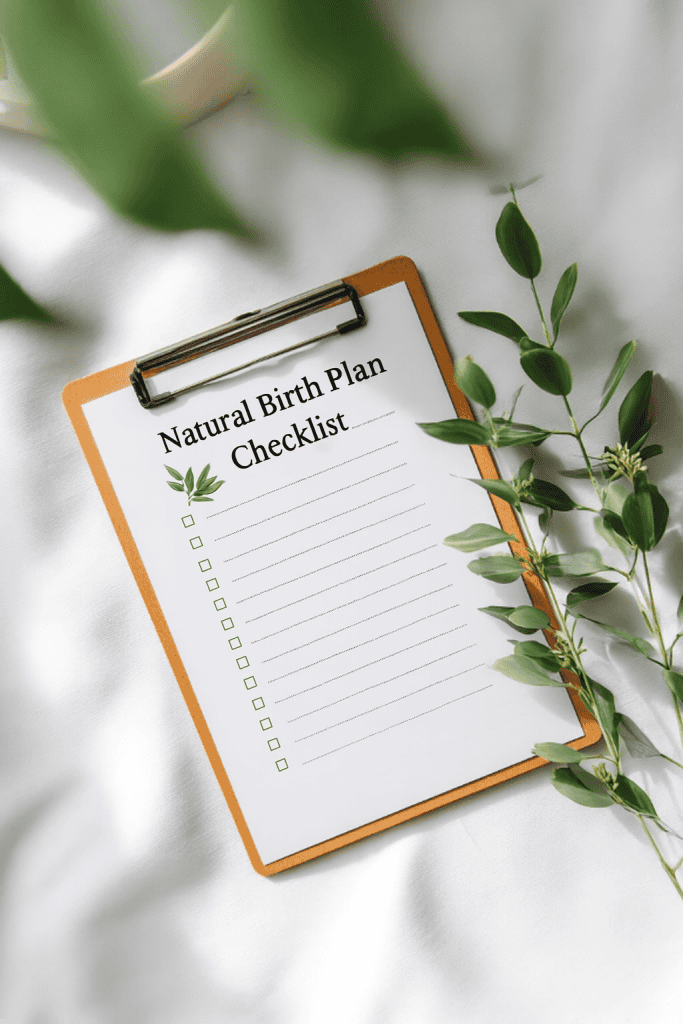Welcoming a new life is one of the most remarkable seasons in motherhood.
As you prepare for your baby’s arrival, having a clear birthing plan can be a source of calm and confidence.
A natural birthing plan helps you express your values, preferences, and hopes in a way that feels both supportive and clear.
Think of it as a guide that allows you, your partner, and your care team to work together in harmony.
When your wishes are written down, you create space for peace of mind and a sense of readiness.
Instead of wondering how things will unfold, you’ll have a thoughtful outline that reflects your voice and helps those around you understand how to best care for you.
This checklist is here to help you gather your thoughts, make empowered choices, and prepare for a safe, supported birth experience.
What Is a Natural Birthing Plan?

A natural birthing plan is a simple yet powerful tool for expecting moms.
It is a written guide that outlines how you would like your labor and delivery to feel and flow.
Think of it as a thoughtful expression of your values and preferences, created to bring clarity and comfort as you approach birth.
At its heart, a birthing plan reflects connection more than control. It helps your partner, care team, and support people understand what matters most to you.
By putting your wishes into words, you create an environment where your voice is honored and your choices are respected.
Whether you imagine quiet lighting, supportive touch, or freedom to move through different positions, your birthing plan captures those hopes.
It becomes a touchstone, guiding your journey and helping everyone around you work together with ease and confidence.
5 Core Elements of a Natural Birthing Plan

Every mom’s birthing plan will look a little different, but there are a few key areas that help bring clarity and peace of mind.
These core elements create the framework for your plan, offering both structure and space for your personal preferences.
1. Setting and Atmosphere
The environment where you give birth shapes the entire experience.
Whether you feel most comfortable at home, in a birthing center, or in a hospital, it’s important to think about the atmosphere you’d like to create.
You might prefer dim lighting, calming music, or a familiar scent that helps you relax. Simple touches like these make the space feel safe and welcoming.
2. Support Team
Birth is a shared journey, and choosing who will be by your side matters deeply.
Your partner, a doula, a family member, or a close friend may all play important roles.
Consider not only who you want present, but also how you’d like them involved – whether it’s holding your hand, offering encouragement, or simply being a quiet presence in the room.
3. Comfort Measures
There are many natural ways to ease sensations and support your body during labor.
You may want to use breathing techniques, warm baths, or gentle massage.
Movement can also be powerful – walking, swaying, or leaning into a birth ball.
Even something as simple as choosing what you wear can make a difference, giving you a sense of ease and freedom.
4. Medical Preferences
Every mom has unique hopes when it comes to medical care.
Some prefer intermittent monitoring instead of continuous, while others want to keep IVs or medications to a minimum.
You may also want to include gentle practices like delayed cord clamping, which supports your baby’s transition after birth.
Writing these preferences down helps your care team understand what feels best for you.
5. Birthing Positions
Your body instinctively knows how to move during labor.
Many moms find strength and relief in upright positions such as squatting, kneeling, or leaning forward.
Others prefer side-lying or hands-and-knees.
Including these choices in your plan ensures you have the freedom to follow your body’s natural rhythms.
Immediate Post-Birth Preferences

The first moments after birth are deeply meaningful, both for you and your baby.
Including your preferences for this tender time in your birthing plan ensures that your wishes are understood and supported.
Bonding Moments
The golden hour (the first hour after your baby’s arrival) is an opportunity for connection.
Many moms choose immediate skin-to-skin contact, allowing warmth, touch, and scent to create comfort for both mother and child.
You may also prefer to delay weighing or routine checks until after you’ve shared this quiet bonding time.
Newborn Care Choices

Your plan can also outline how you’d like your baby’s first care to unfold.
This may include beginning breastfeeding right away, choosing whether your baby receives vitamin K, or noting your thoughts on eye ointment and vaccines.
When these details are written down, your care team can support your family’s choices with ease.
Placenta Plans
For some families, the placenta carries personal or cultural significance.
You may wish to include your preferences for delivery, encapsulation, or other traditions.
Even if you haven’t decided, simply noting that you’d like time to consider keeps the moment intentional.
These gentle choices give shape to your baby’s first hours, ensuring they begin with warmth, connection, and care.
Building Flexibility Into the Plan
A natural birthing plan is a guide, not a script.
It reflects your voice, your hopes, and your preferences – but it also leaves room for the natural flow of birth.
Including flexibility in your plan allows you to stay centered and calm, no matter how your journey unfolds.
Think of your plan as a compass. It points you toward what matters most (comfort, safety, and connection) while still giving you freedom to adjust if needed.
This outlook helps you remain at peace, knowing that even with small changes, your core intentions are still guiding the experience.
Flexibility is not about giving up choices; it’s about holding them with open hands.
It ensures that you feel supported and respected while allowing your care team to work with you in harmony.
With this balance, your plan becomes both practical and empowering – a steady source of reassurance as you welcome your baby.
Natural Birthing Plan Checklist (Personalize for Your Birth)

Here’s a checklist you can adapt to reflect your own values and preferences.
Use it as a guide, and add your personal touches where needed.
Environment & Atmosphere
- Preferred birth location: home / birthing center / hospital
- Lighting: dim / natural / bright
- Sounds: music / quiet / affirmations
- Scents: essential oils / fragrance-free
- Privacy preferences
Support Team
- Partner present and role
- Doula or birth coach
- Family or friends
- Care team involvement (nurses, midwives, doctor)
Comfort Measures
- Breathing techniques
- Movement: walking, swaying, birthing ball
- Water immersion: shower / tub
- Massage, touch, or acupressure
- Clothing preference for comfort
Medical Preferences
- Monitoring: intermittent / continuous
- IV fluids: minimal / as needed
- Pain management: natural methods / epidural avoidance
- Cord clamping: delayed / immediate
- Placenta: deliver naturally / encapsulation / other
Birthing Positions
- Upright: squatting / kneeling / standing
- Hands-and-knees
- Side-lying
- Freedom to move and shift
Immediate Post-Birth
- Skin-to-skin contact
- Golden hour bonding
- Breastfeeding initiation
- Delay weighing and measuring
- Newborn care: vitamin K / eye ointment / vaccines
- Placenta plans
Extras
- Photography or video preferences
- Cultural or spiritual traditions
- Notes or affirmations for care team
Tips for Sharing and Using Your Plan
A birthing plan is most helpful when the people around you know it well.
Once you’ve written yours, take a little time to share it and make sure it’s easy to use when the big day arrives.
- Review with Your Provider: Bring your plan to an appointment and go over it with your midwife or doctor. This helps ensure that your preferences align with what’s available in your chosen birth setting, and it allows your care team to support you with clarity.
- Keep Copies Handy: Print a few copies to tuck into your hospital bag or keep near your birthing space. Hand one to your nurse or midwife, and give one to your partner or doula so they can advocate for you when you’re focused on labor.
- Post It Where It’s Visible: If you’re birthing at home or in a center, placing a copy on the wall or bedside table makes it easy for anyone entering the room to quickly understand your wishes.
- Keep It Clear and Simple: A concise plan is more likely to be read and remembered. Bullet points, short phrases, and organized categories make it easy for your team to follow.
By sharing your birthing plan thoughtfully, you create a circle of understanding – ensuring that everyone who supports you is on the same page, ready to honor your choices.
Embrace Your Natural Birthing Plan with Confidence

Creating a natural birthing plan is more than filling in a checklist – it’s an intentional step toward welcoming your baby with clarity and peace of mind.
By outlining your preferences, you strengthen your voice, invite your support team into your vision, and prepare for a birth experience that reflects your values.
As you move forward, remember that your plan is both a guide and a source of reassurance.
It reminds you that you are prepared, supported, and capable.
No matter where your journey leads, your thoughtful preparation lays the foundation for a birth filled with confidence, strength, and love.
What’s one preference you know you’d like to include in your birthing plan?
Share it in the comments below – I’d love to hear how you’re preparing for this beautiful season of motherhood.
FAQs
How detailed should my natural birthing plan be?
Your birthing plan should be clear and concise. Focus on the essentials – environment, support team, comfort measures, medical preferences, and newborn care. Short bullet points or simple phrases make it easy for your care team to understand and follow.
When should I write my birthing plan?
Most moms create their birthing plan in the second or early third trimester. This gives you time to discuss it with your provider and make adjustments as you learn more about your preferences.
Do I need to bring my birthing plan to the hospital or center?
Yes, bring a few printed copies. Give one to your nurse or midwife, keep one with your partner or doula, and post one in your birthing space for quick reference.
Can I still have a natural birthing plan if I choose a hospital birth?
Absolutely. A natural birthing plan works in any setting – home, birthing center, or hospital. It simply outlines your preferences and helps your care team support you in a way that feels right for you.
Should my partner be involved in creating the plan?
Yes, involving your partner strengthens your support system. They’ll understand your wishes and feel more prepared to advocate for you, especially during moments when you’re focused on labor.

